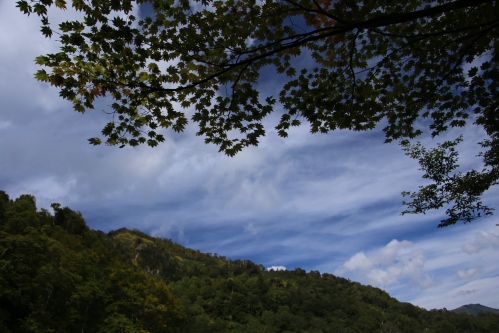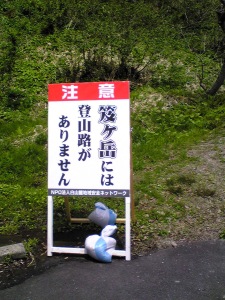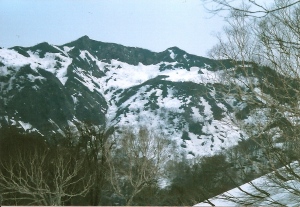At 6am on a bright sunny Saturday in mid-September, the planets aligned and the stars converged on Togakushi kogen for a meeting of the mountaineering minds. Rie and Paul set up camp next to my alien-green spaceship as Yuta and his companion dropped off their intergalactic hovercraft in a vacant docking station. Excess gear was safely stowed as the explorers donned their space helmets and jetpacks for the journey of a lifetime.
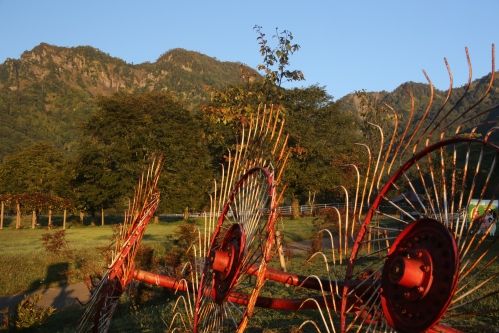
Yuta’s party started out ahead of us, since they were teleporting themselves up the impossibly steep slopes of Mt. Takazuma. Rie, Paul and I ducked into the forest just behind our camp for a gentle 3 kilometer warm-up through untouched forests of beech, fir, larch, and other hardwoods. At one point, around 10 minutes into our mission, we spotted an ancient tree towering high above the forest floor, the branches spreading in all directions like a natural manifestation of Avalokiteshvara. Something about that tree really struck me, but I couldn’t put my finger on it. All of us commented on the sheer size and beauty of the tree, wondering how long it took such a structure to reach maturity. We continued on a couple of meters before hearing the unmistakable sound of breaking tree branches, followed by a dull thud. Apparently, a black bear had been enjoying a quiet breakfast in that very tree until our voices startled it enough to flee. Though neither of us had seen the creature, we were all sure of exactly what it was. From that point on, we needed to be a bit more receptive to our earthly surroundings.
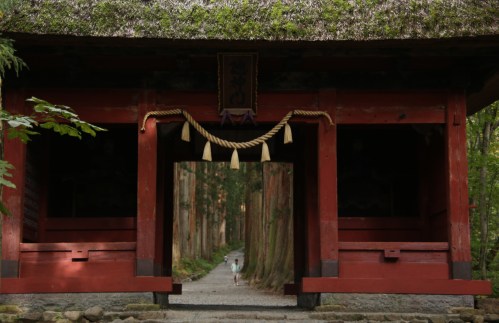
Our unexpected encounter did have one advantage: the adrenaline surging through our blood had suppressed the fatigue and drowsiness, two things we did not need interfering with the concentration required on the impending climb. The forest gave way to a plantation of larch before spitting us out in front of a thatched temple gate marking the entrance to Togakushi shrine. This area used to be home to a large temple in the Tendai sect of Buddhism until Shinbutsu bunri put an end to that. Mt. Togakushi was, for centuries, one of the biggest training grounds for Tendai monks outside of Hieizan. Unlike the marathon walkers of Mt. Hiei, the monks sought enlightenment by scaling the near vertical walls and meditating in hidden caves dotted throughout the area. Nowadays you’d be hard-pressed to find even a monk, let alone a white-clad yamabushi. A row of giant cryptomeria line either side of the gravel approach to the main shrine building. Imagine the Daimonzaka trail at the Kumano Kodo on steroids.
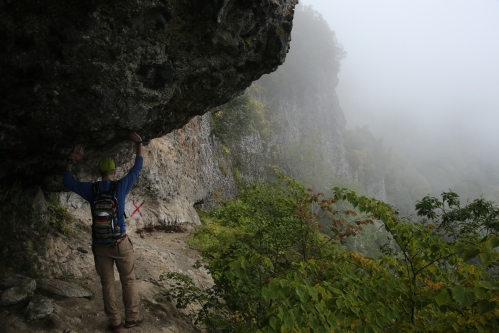
Just before the main shrine building, the trail to Togakushi split off to the left. We entered the forest and immediately started the steep climb up a spur to the ridge. The first 30 minutes were fairly easy to manage, until the path reached the base of an enormous cliff face. From here, the route turned west, skirting the edge of the igneous wall with nice views across the forest canopy to the slopes of Mt. Iizuna. The path disappeared into the cloud dangling directly above, and once around the largest of the rock formations, the real climb commenced. A chain dangled from the top of a stone tower hidden by the cloud as Rie grabbed on and heaved herself up. The network of chains increased as we literally pulled ourselves up from the forest clinging tightly to the rocky terrain. Fortunately the chains weren’t in a continuous strand: after a long chain section there was usually a relatively flat area to traverse through before reaching the next rock formation.
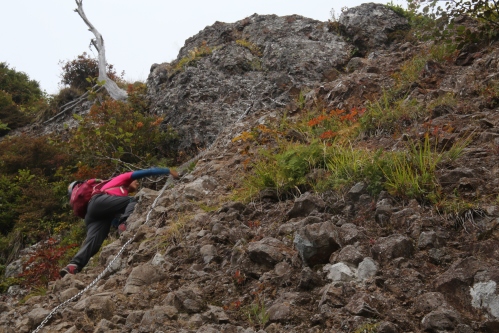
Higher up the boulder maze, we reached a long section of nearly vertical rock face, pockmarked from the ancient volcanic forces that thrust the entire mountain range towards the sky. Rie led the way, shouting from above that the section was ‘taihen‘. Once she safely topped out, I lunged forward, grabbing the chain in my right hand while grasping the left onto any cankerous protrusions of crusted rock. The legs did their best impression of the Harlem Shake during the 40-meter scramble. Once on top I collapsed in a heap of perspiration and fatigue. I turned around just in time to see Paul standing perched on a precarious ledge, left hand outstretched in an improvised attempt at a selfie. His confidence with heights had Rie and I salivating with envy. At the top of the next scramble the path flattened out, narrowing to a scrawny backbone of a ridge that was marked on the maps with a danger symbol. The ridge, if you could call it that, was crumbly and barely the width of a balance beam in spots. The best approach was straddling the beast like a bucking bronco: a time when form definitely followed function.
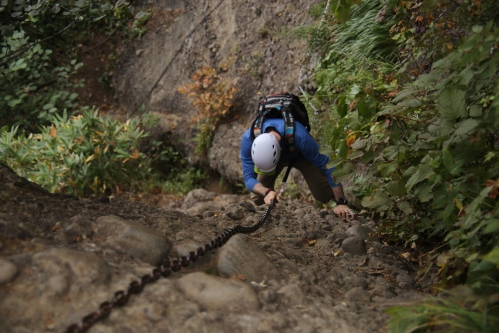
Paul walked gallantly on some of the more exposed sections, a true testimonial to those long hours on the slackline put to practical use. Rie and I scooted along behind our acrobatic master like two ducklings following their brave mother across the Hoover Dam. Fortunately the knife-edge eventually gave way to solid, tree-covered soil and it was simply a matter of hoisting ourselves over a duo of chains before popping out on the meter-wide catwalk of the true ridge itself. We used the extra space to sprawl out and catch our breath, hoping the fog would lift enough to actually see our approach route clearly. After ten minutes we gave up and turned east along the rolling contours of the high ridge. There were plenty of ups and downs on the jagged spine of the mountain, but eventually we topped out on the official high point, congratulating ourselves with a well-earned summit snap.
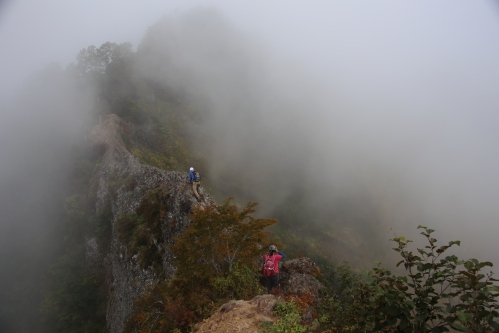
The further east we traversed, the better the visibility, as the fog lifted completely and afforded unobstructed views into the forests we had trudged through earlier in the morning. To the north, the pyramidal mastiff of Mt. Takazuma poked its head out of the condensation bank to offer a jovial greeting. Paul and I snapped away, trying to capture the scenery with our lenses while Rie trudged along ahead at her own brisk pace. Cliff faces tinged with autumn hues rose triumphantly towards the azure sky like soldiers saluting their major general.
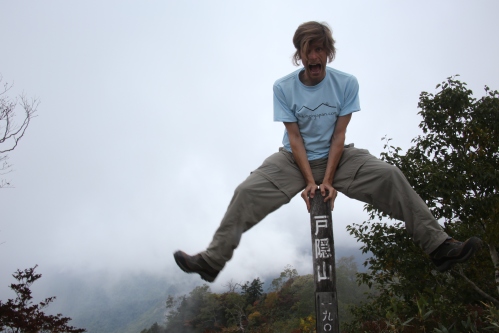
Though fatigue was slowly taking hold, the warm sunshine brightened our spirits during the ramble along the undulating ebbs and flows of the uplands. An hour after breaching the ridge, we passed our first hikers of the day: a husband and wife team that had started out nearly an hour before us. A bit further along, a middle-aged Japanese hiker drenched in sweat approached us, offering a greeting that took us a bit aback. “Are you with Hiking in Japan?”, the mountaineer inquired. It turned out to be Toshi, one of the members of the Facebook community who had driven up from Matsumoto in order to join us for dinner at the campsite that evening.
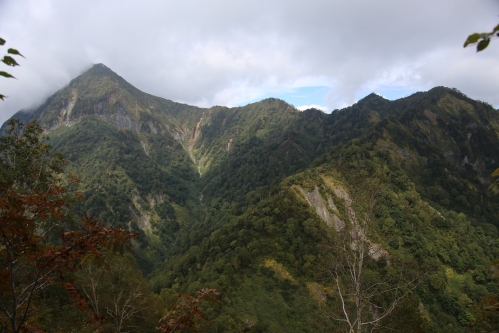
The track lost altitude quickly, bottoming out at a saddle marked by an emergency hut whose construction was fit for a bomb shelter. It was here that we found Rie chatting with Yuta’s party who had just successfully descended from Mt. Takazuma. I remember this emergency hut with fond memories during my own snow-capped, adrenaline-laced summit of Takazuma during my Hyakumeizan quest.
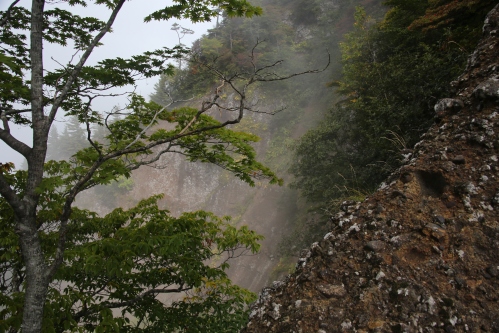
With five people now in our party, we descended the steep gully which wound its way past a couple of waterfalls before eventually spitting us out into the cow pastures of Togakushi farm. Again, Paul and I found ourselves captivated by a troupe of wild monkeys as the others pushed ahead, anxious for a hot spring bath to wash away the volcanic filth. We couldn’t pass up an opportunity to hone our wildlife photography skills, even if they were on some very uncooperative subjects.
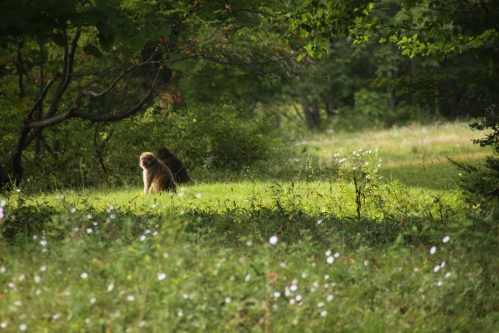
Once back into civilization, we spied a cafe serving pizza made from buckwheat flour. We plopped ourselves at one of the outdoor tables and split a pizza while each ordering a dish of yaki curry, a dish that can only be described as an improvised version of gratin, but instead of baking a pot of potatoes and cheese, the basin was filled with curry and rice. When those steaming ceramic bowls of furnace-temperature curry were delivered to the table our eyes nearly bulged out of their sockets.
Perhaps we overdid it a bit on the carbs, but an epic climb deserved an epic reward. Once back at camp we met up with the rest of the Hiking in Japan members (a full report can be read here) and round two of the festivities commenced. Togakushi was a mountain definitely worthy of our attention, and I could finally check that mountain off the list despite two earlier aborted missions. Now it was time to turn my attention to the rest of the peaks surrounding the idyllic crater basin of the Togashushi Highlands.
